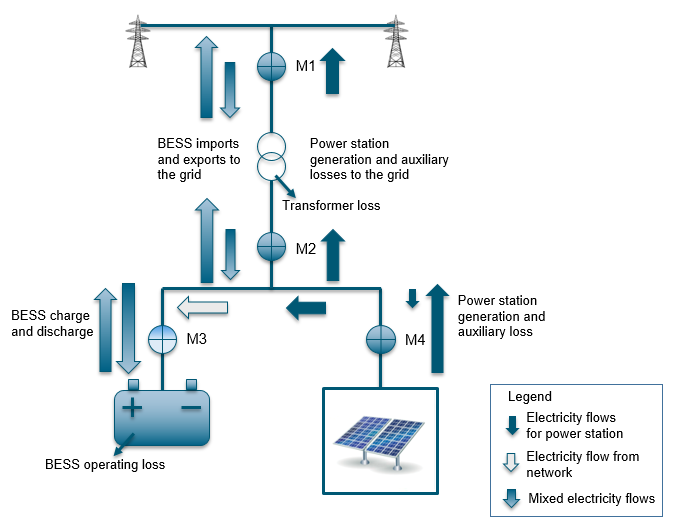This guidance provides information on a sub-metering methodology that can be used to calculate large-scale generation certificate (LGC) entitlement for accredited power stations with a utility-scale Battery Energy Storage System (BESS).
This methodology ensures that:
- all eligible electricity generation from the power station continues to be eligible for LGCs regardless of the BESS
- the electricity utilised in the operation of the BESS is not included as auxiliary loss for the power station, and
- the power station’s Marginal Loss Factor (MLF) is applied only to electricity that is dispatched to the network either directly from the generating components or indirectly via the battery.
This method is not mandatory, and may not apply to all configurations. Alternative arrangements will be considered by the Clean Energy Regulator through engagement with the nominated person for the power station. Continued use of a LGC methodology based solely on the revenue meter may result in reduced LGC entitlement.
Please note: this information is intended for use as guidance only and is not to be relied upon as legal advice.
Sub-metering method
This LGC methodology differentiates electricity generated by the power station from the electricity sourced from the network to operate the BESS. Additional metering is required to ensure all eligible electricity generation from the power station continues to be accounted for irrespective of it being used in the operation of the BESS. Installation of sub-meters maximises entitlement and enables the calculation of any liable electricity. This is demonstrated in the figure below.

Applying sub-meters to the General Formula
The following method of calculating LGC entitlement in accordance with the general formula is applicable to an accredited power station such as a wind farm or solar farm registered as a market generator. The method is premised on applying cumulative meter data.
TLEG
TLEG, the amount of electricity generated by the power station, is measured by meter M4.
This is expressed as:
TLEG = \(\textrm{M}4_{out}\)
AUX
The Renewable Energy (Electricity) Regulations 2001 stipulate how auxiliary loss applies. M4in measures electricity integral to the operation of the power station. This measurement requires adjustment to allow for loss associated with any transformer and any other equipment associated with delivery of electricity to the generation system (%TFR):
DLEG
DLEG is the amount of electricity transmitted or distributed by the power station. DLEG is equal to the electricity delivered to the transmission network minus any imported electricity returned to the network by the BESS.
Losses associated in operating the BESS can be calculated in the following manner:
Transformer loss in = \({\textrm{M}2_{in}} \over {\textrm{M}1_{in}}\)
BESS loss = \({\textrm{M}3_{out}} \over {\textrm{M}3_{in}}\)
Transformer loss out = \({\textrm{M}1_{out}} \over {\textrm{M}2_{out}}\)
BESS return = \((\textrm{M}1_{in} - \textrm{AUX}) \times {\textrm{M}2_{in} \over \textrm{M}1_{in}} \times {\textrm{M}3_{out} \over \textrm{M}3_{in}} \times {\textrm{M}1_{out} \over M2_{out}}\)
DLEG = \({\textrm{M}1_{out}} - {\textrm{BESS return}}\)
MLF
The Clean Energy Regulator applies generator MLFs calculated and published by the Australian Energy Market Operator, and equivalents calculated by other market operators, to electricity dispatched by market generators operating as accredited power stations.
Worked Example
A solar farm is used for illustration. The following assumptions have been made:
- measurements are recorded for the monthly operation of the solar farm incorporating a BESS. Solar farm generates 11,500.0 MWh and supplies 1,500.0 MWh to BESS
- BESS loss Factor is 0.88
- transformer efficiency is 94%
- auxiliary supplied to solar farm (read from M4in) is 9.4 MWh
- no supplementary onsite generation (i.e. FSL is 0.0)
- MLF is 0.9000
- M1in Electricity drawn from network at connection point 1,700.0 MWh
- M2in Network electricity drawn across transformer = 1,598.0 MWh
- M3in Electricity supplied to BESS = 3,088.6 MWh
- M4in Auxiliary supplied to solar farm = 9.4 MWh
- M4out Electricity generated by solar farm = 11,500.0 MWh
- M3out Electricity returned by BESS = 2,717.968 MWh
- M2out Electricity originating from solar farm plus electricity returned by BESS = 12,717.968 MWh, and
- M1out Electricity delivered across transformer (94% efficient) to connection point = 11,954.890 MWh.
Working out eligible electricity
Eligible Electricity = \({\textrm{TLEG}} - (\textrm{FSL} + \textrm{AUX} + (\textrm{DLEG} \times (1 - \textrm{MLF})))\)
TLEG is Electricity generated by solar farm = M4out = 11,500.0 MWh
AUX is Auxiliary electricity established at connection point = \(\textrm{M}4_{in} \times {\textrm{M}1_{in} \over \textrm{M}2_{in}} = 9.4 \times {1,700.0 \over 1,598.0} = 10.0\textrm{MWh}\)
BESS return = \((\textrm{M}1_{in} - \textrm{AUX}) \times {\textrm{M}2_{in} \over \textrm{M}1_{in}} \times {\textrm{M}3_{out} \over \textrm{M}3_{in}} \times {\textrm{M}1_{out} \over \textrm{M}2_{out}} = (1,700.0 - 10.0) \times {1,598.0 \over 1,700.0} \times {2,717.968 \over 3,088.6} \times {11,954.890 \over 12,717.968} = 1,314.09\textrm{MWh}\)
DLEG is electricity established at connection point = M1out – BESS return = 11,954.890 – 1,314.09 = 10,640.80 MWh
Eligible Electricity
= TLEG – (FSL + AUX + (DLEG × (1 – MLF)))
= 11,500.0 – (0 + 10.0 + (10,640.80 × (1 – 0.9000)))
= 10,425.92 MWh
= 10,425 LGCs (plus carry over = 0.920 LGCs)